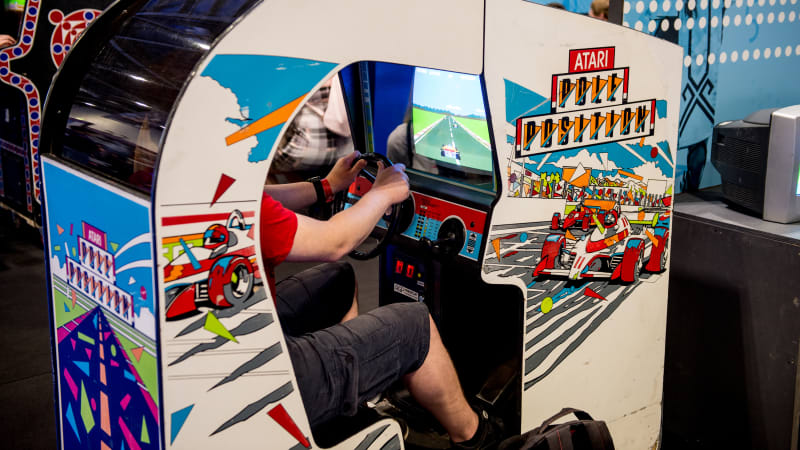Audi Repair Shop Doylestown
Call 267 279 9477 to schedule a appointment

Pole Position wasn’t the first racing game when it hit the scene way back in 1982, or even the first the adopt a rear-chase view. But Pole Position captured the imaginations of arcade-goers and became the spiritual ancestor of most racing games that followed. At the time, Pole Position conveyed speed and accuracy in a nearly revolutionary way. It became phenomenally successful during its heyday. Pole Position also marked the first appearance of a real track in a video game – Fuji Speedway.
But Pole Position isn’t the only driving game that helped define the segment. Below are 10 more that we think deserve special recognition.
Out Run – 1986
Another wildly successful racing game from the golden age of arcade cabinets, Out Run looked miles ahead of the comparatively primitive Pole Position. For one, there was a recognizable – albeit unlicensed – real-world car in the game, a Ferrari Testarossa Spider. And as opposed to the rigid linearity of Pole Position and other early racing games, Out Run was sort of a predecessor of modern open-world games like Forza Horizon – occasional forks in the route can take players to one of five final destinations. In your Fauxrari, you aren’t racing except to reach the next checkpoint and continue, dodging traffic and trying to stay on the road until the finish line. By not directly emulating real-world racing, Out Run helped expand the genre.
F-Zero – 1990
If Out Run helped expand the horizons of what could be considered a racing game, F-Zero finished the job. A launch title for the Super Ninendo Entertainment System, this unconventional race game preceded Mario Kart and introduced a futuristic setting that other games would later emulate. As a console racing game, it also brought fast, exciting pseudo-3D racing into the home, using some clever graphics techniques and hardware built into the SNES. Of course, the hovercraft themselves and the otherworldly tracks captured the imagination, too.
Super Mario Kart – 1992
F-Zero didn’t launch a juggernaut of a franchise, but it did get Super Mario Kart off the ground. Development of a two-player version of F-Zero led directly to the split-screen racing concept, while Super Mario Kart also utilized the Mode 7 graphics technique developed for the earlier game. A roster of notable characters – Mario, Luigi, Yoshi, Bowser, Princess Peach, Toad, Donkey Kong Jr,. and Koopa Troopa – each came with their own strengths, and a plethora of power-ups meant that the outcome could change based on skilled play or a lucky turtle shell strike. It was an instant hit and a massive success over time for Nintendo, and more importantly revealed the potential for both multi-player and “fun” – as opposed to simulator – genres.
Daytona USA – 1993
SEGA placed a risky bet with Daytona USA: that expensive new hardware with unprecedented graphics would create an irresistible sit-down arcade experience. They won that bet many times over, as Daytona USA became the most profitable arcade system of its kind. It was the first title to launch on its newest arcade hardware that enabled full texture-mapping, making it one of the most graphically-detailed games of its time. It was also a real step up from Virtua Racer, which preceded it on older hardware. The cabinets allowed multiplayer gameplay for up to eight racers. Daytona USA established the importance of cutting-edge graphics in the racing genre, but realistic physics were just around the corner.
Ridge Racer – 1993
Perhaps the granddaddy of serious simulator racing games, Ridge Racer debuted as an arcade game and crossed over to consoles the following year as a launch title for the original Playstation. In its earliest incarnations, Ridge Racer’s physics were rudimentary and the camera fixed at a low angle, but it showed the way for more realistic road racing to come – and it allowed for primitive drifting techniques way before anyone outside of Japan was broadly familiar with the concept. All that would change soon enough.
Sega Rally Championship – 1994
The games that followed and that rally fans argue over – Richard Burns, the Colin McRae series, DiRT – owe a lot to this arcade game, which introduced different driving surfaces with differing traction levels. It was the first game to do so and thus an essential element in the development of all racing games that came after. The main vehicles, too, are thrilling – a Toyota Celica GT-Four or a Lancia Delta HF Integrale. Its three fictional race stages would be overtaken in realism by later games, but no one can deny its significance in furthering the physics models for future simulation games.
Gran Turismo – 1997
No single title has so monumentally changed the genre as the original Gran Turismo. Released after five years of development headed up by Kazunori Yamauchi, instead of a small handful of cars it included well over 100. There were 11 tracks, as well, although all were fictional. Cars could be modified, and players could select which cars and events they wanted to participate in. The depth of choice and the free-flowing advancement, the massive jump in realism, and the emphasis on being a “serious” racing simulator for the original PlayStation console created a monumentally important and successful series. It also invited competitors to try their hand at besting it in the coming years.
Star Wars Episode 1: Racer – 1999
While other series perfected realism – in graphics, sound or physics – this game was set in the Star Wars universe, was released concurrently with the first prequel film, and featured perhaps the movie’s most compelling experience: pod-racing. While the movie it was based on was generally panned, the sci-fi racing game it spawned became the most successful of its type ever. Credit goes to developer LucasArts’ focus on conveying the sensation of incredible speed. Drawing on actors, scenes, and, perhaps most important, music from Episode 1, it created a surprisingly successful blend that appealed to both racing game fans and Star Wars nuts. Multiplayer support didn’t hurt its appeal any, nor did its release on PC and several home game systems. It also spawned a follow-up arcade version called Star Wars: Racer.
Forza Motorsport – 2005
PlayStation’s Gran Turismo series got a rude awakening when the original Forza Motorsport debuted with a similar overall concept but important detail differences – damage modeling, for one, but also the innovative “drivitar” AI that allows the computer to learn your techniques and participate for you in races you want to skip. That little gimmick served to up the simulator AI game in general, leading to a bit of an arms race for more entertaining or realistic AI in racing games overall. It also appealed to those looking to try and collect some of the hundreds of different cars it featured, as well as real-world and fictional tracks. The rivalry between Turn 10 Studios and Polyphony Digital continues to this day, and it all started here.
Need For Speed III: Hot Pursuit – 2010
The original Need for Speed was an early attempt at realism, with input form the editors of Road & Track to match handling characteristics with real vehicles. The franchise quickly abandoned that more serious tone and adopted some arcade-style gameplay. But it finally came into its own with Hot Pursuit, which featured incredible graphics, fully licensed and suitably exotic cars, and a cops-and-crashes gameplay model that was addictive. Crashes used to be something players cringed at, but in Hot Pursuit they are gorgeous moments of exquisite destruction, a key part of the gameplay and a major part of the appeal. The environments received similar attention, with beautiful detailing, weather effects, and time of day. Despite its arcade focus, its technical achievements pushed all racing games forward.
Autoblog is a participant in the Amazon Services LLC Associates Program, an affiliate advertising program designed to provide a means for sites to earn advertising fees by advertising and linking to amazon.com. These deals are available through our affiliate partnership with Amazon.com. Deals are subject to Amazon’s schedule and availability.
from Autoblog https://ift.tt/2C5F18g
